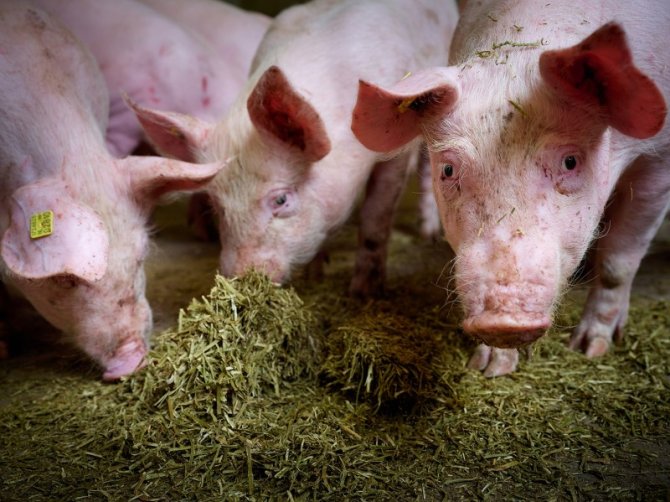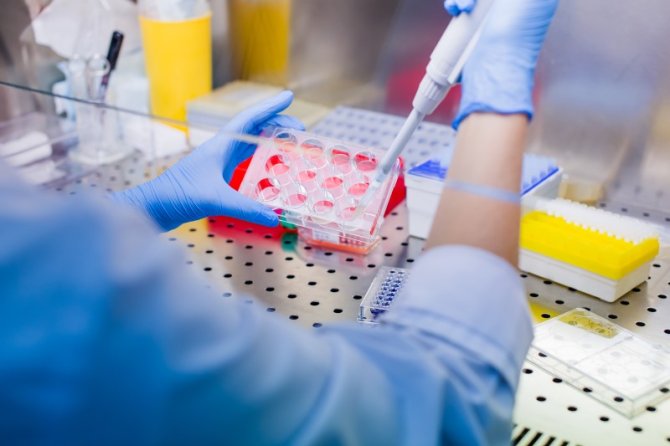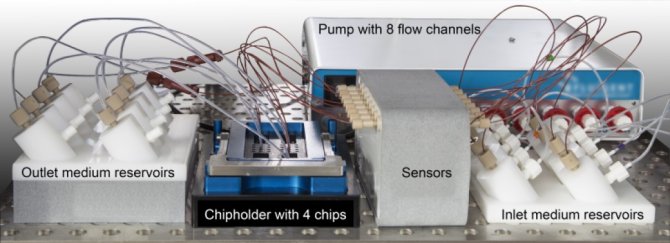
News
Mini intestines replace test animals
What effects do food components have on the human body? Scientists at three Wageningen research institutes are working on a new way of answering that question. They’re doing so by developing organoids using intestinal cells harvested from humans and pigs. This will drastically reduce the need for test animals in future, according to food safety researcher Meike van der Zande.
New food products must undergo extensive research into the safety of every ingredient before they can be put on the market. Animal tests are often required as part of the certification process. But eventually, these animal tests should no longer be necessary, according to researchers currently working on alternative methods. One such alternative is the use of cells that act as mini-organs, known as organoids.
Humans and pigs
Meike van der Zande is a research associate at Wageningen Food Safety Research, where she cultivates intestinal organoids from human stem cells. The idea is to use these organoids to test whether certain substances are harmful to human health. Her team is working with researchers at Wageningen Food & Biobased Research who are also growing mini-intestines from human stem cells. Their focus, however, is the impact of healthy substances.

A third research institute, Wageningen Livestock Research, is working on the development of organoids based on pig stem cells. “These three research projects all have the same objective but they’re coming at it in slightly different ways,” says Van der Zande. “We’re looking at how substances are absorbed and processed in the intestine, and the impact they have. Do we actually want these substances to be absorbed? The same questions apply to pigs, because we want them to stay as healthy as possible too.”
New alternative
Until about 10 years ago, animal testing was much more routine as a way of measuring the effects of certain food components. It was simply the best available option. Cells could also be cultivated in a petri dish, but this was only relevant to a limited aspect of the research. There were inevitable drawbacks to both types of research. “Mice are not humans or pigs, and individual cells do not act in the same way as an entire organ. Applying the findings to the human body is often problematic,” according to Van der Zande.
The cultivation of an organoid starts with stem cells. These cells can go on to develop into a variety of other cells found in the body
There are also ethical problems with the use of test animals. “Unfortunately we can’t yet eliminate animal testing altogether, but we can further reduce the number of test animals used,” she argues. Organoids are a solution to both these issues. A cluster of cells that develops into a mini version of the relevant organ is closer to the real thing and reduces the need to use test animals.
Stem cells
The cultivation of an organoid starts with stem cells. These cells can go on to develop into a variety of other cells found in the body. “We let them develop into different types of intestinal cells, such as goblet cells that secrete mucus, endocrine cells that produce hormones, and epithelial cells,” Van der Zande explains. Epithelial cells play an important role in transportation and one of their functions is to break down toxic substances. They also communicate with intestinal bacteria. A single organoid is made up of tens of thousands of cells.

The three research institutes are using two different sources of stem cells. The easiest stem cells to obtain are those that can be produced from cells derived from organs other than the intestine, such as the skin. It’s more complicated to obtain actual intestinal stem cells. “The former are often obtained from healthy people,” says Van der Zande. “With intestinal stem cells it’s different. We get those from hospitals. It could be a piece of healthy tissue at the edge of an intestinal tumour, removed during an operation. We don’t know yet what type of stem cell will create the best intestinal organoids for our research. That’s something we want to find out through our collaboration with the other institutes.”
From biology to technology
If you’re picturing an organoid as a tiny piece of intestine in a little dish, you might be disappointed. Mini-organs don’t necessarily need to look like the real thing, they just need to function in a comparable way. Van der Zande works for that reason with a complex set-up based on a thin layer of cells. A liquid form of ‘food’ flows along the top of this layer of cells, just as it would in the intestine, and ‘blood’ flows along the underside of the layer of cells. “Sensors and chips allow us to study these liquid flows at a microscopic level,” says Van der Zande. “This gives us a much closer comparison to what actually happens in the human body.”
Applying this to the human body is problematic: mice are not human, and individual cells are not complete organs
Once it’s been absorbed, a substance will continue to move around the body. “Substances are stored, expelled or broken down. We’re developing computer models for this based on knowledge drawn from previous research using human and animal tests.” Taken as a whole, this provides a good picture of the effects that healthy and unhealthy substances have on the body.
Fewer test animals
“The power of our research is that it’s improving our ability to select specific substances. This is relevant to research into the effects of per- and polyfluoroalkyl substances (PFAS), for example. These are found in non-stick layers applied to pans, and there are many different types. We already know that certain types are more prone to absorption by intestinal cells and therefore get into your body. Based on that knowledge, you could decide to use animal testing only for those types,” explains Van der Zande.

Connecting the different models will also further improve our ability to select specific substances in future. “A substance might be very easily absorbed but subsequently be so thoroughly broken down by the liver that it barely does any damage,” she says. “Whereas a substance that is only absorbed to a limited extent, but then also hardly broken down at all by the liver, could be more dangerous. If you then do need to carry out animal testing, you can be more certain that you’re dealing with the right substance. This means fewer animals need to be used for testing.”
Another example is research into new sources of protein. “A new Europe-wide project is about to start in which we’ll be researching some of these new proteins, such as those derived from insects. We’ll be assessing the potential risks.” Intestinal organoids are expected to play a role in selecting proteins that need further research.
A world without test animals?
Van der Zande has noticed how her research has caught the attention of politicians and the general public. Over the past few years in particular, there’s been growing interest in finding alternatives to animal testing. However, much more research has to be done before organoids can be routinely used for certifying new food products. “When it comes to regulation, you need to be certain of the value of a model. Any predictions you make through it must be reliable. It takes time to get to that next step.” Still, she is optimistic that her organoids will succeed.
But will food safety research ever be able to dispense with test animals altogether? “Some scientists think we could get there within 10 years. Others think some animal testing will always be necessary.” Van der Zande is cautiously optimistic. “I think it’s possible, but I think it will take another 30 years or so. We do need to get there, because nobody actually wants to be testing on animals. I want to do everything I can to find an alternative.”